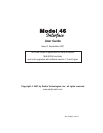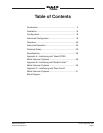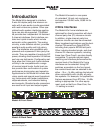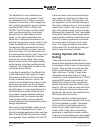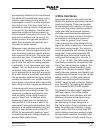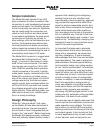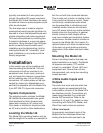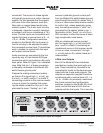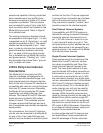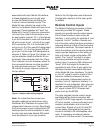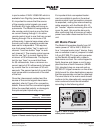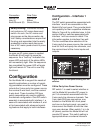
Model 46 User Guide Issue 2, September 2007
Studio Technologies, Inc. Page 7
are especially sensitive to this requirement.
The Model 46’s sophisticated auto nulling
function uses analog circuitry under mi-
croprocessor control to achieve significant
trans-hybrid loss. This return-loss “null” is
achieved by making a series of adjustments
to account for the resistive, inductive, and
capacitive conditions that are present on
the connected 2-wire party-line circuit. The
party-line’s conditions are the sum of the
impact made by the type and quantity of
cable, the connected user-devices, and
the intercom power source.
Whenever a user presses one of the Model
46’s “auto null” buttons digital circuitry ad-
justs the analog hybrids to rapidly achieve
their maximum return-loss. The nulling pro-
cess takes less than 10 seconds for each
channel of an interface. However, it’s impor-
tant to note that while the nulling process
is automatic, it only takes place upon user
request. This can lead to more stable and
consistent audio performance when a hy-
brid is exposed to the varying 2-wire condi-
tions often found in broadcast applications.
The parameters obtained during the nulling
process are stored in non-volatile memory;
mains power interruptions won’t require the
auto nulling function to again be performed.
A sine-wave audio tone is generated for
use during the auto nulling process. The
frequency is software-controlled to maxi-
mize the ability of the hybrid circuits to
reach a “deep” null. In addition, at the
beginning of each auto null sequence a
short period of 24 kHz tone is sent to the
associated 2-wire party-line interface. This
serves as a microphone disable (“mic kill”)
signal for user devices such as the RTS
BP325. By automatically disabling “open”
microphones the auto nulling process can
achieve better performance.
4-Wire Interfaces
Associated with the 4-wire portion of the
Model 46’s interfaces are analog line-level
inputs and outputs. These are intended
to interconnect with a variety of 4-wire de-
vices, including matrix intercom systems,
audio-over-fiber transmission systems,
and other specialized audio equipment.
The input and output circuitry is transform-
er-coupled to minimize the chance of
hum, noise, or ground “loop” issues.
A key characteristic of the Model 46’s de-
sign is the ability to select the 4-wire input
and output nominal levels. This helps to
ensure compatibility with virtually all audio
equipment. Front-panel-accessible DIP
switches allow the nominal levels to be
configured from among four choices: 0,
+4, +6, or +8 dBu. The 0 dBu setting was
specifically provided for compatibility with
Clear-Com matrix intercom systems. The
+4 dBu setting allows “standard” audio
signals to be directly connected. Digital
matrix intercom systems from Riedel® can
be effectively connected using the +6 dBu
setting. And the +8 dBu setting allows
proper level matching with the popular
ADAM™ series of matrix intercom systems
from Telex/RTS. This setting also applies
to the related RVON-I/O VoIP product.
The Model 46 contains eight 5-segment
LED level meters. Four of the meters
are provided for each interface, with two
displaying the level of the signal being
received from the 4-wire source and
two displaying the level being sent to
the 4-wire output. During installation and
setup the meters are invaluable in help-
ing to confirm that the nominal level DIP
switch settings have been properly made.
During normal operation the meters offer
rapid confirmation of audio signal flow in



